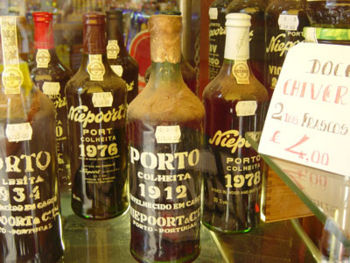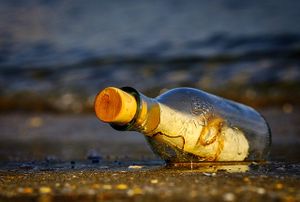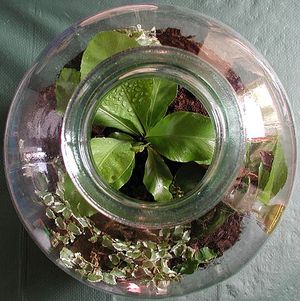Bottle
A bottle is a typically small storage container for liquid. Unlike jugs, casks, and drums, they hold a moderate amount and are intended for short term storage of items in frequent, usually household use, although alcoholic beverages and other preserved items can be stored in bottles for years. The word bottle was originally a French word which entered into English use as early as the 1300s.[1]
Bottles have been in use for centuries. The earliest ones were typically made of leather, wood, earthenware, or metal;[2] the majority of modern ones are made of glass or plastic. The shape varies from bulbous to cylindrical, but a characteristic of bottles is a narrower neck than body. They can range from tiny--for perfume and medicine, for example--to rather large--for large novelty bottles of wine[3] and other alcoholic beverages. Because they are intended to hold liquid, it is important that bottles be made of materials that do not seep, and preferably ones which do not lend chemicals or tastes to the liquid contents. Glass bottles have particular significance; they are non-porous and durable, and unless cracked or broken can store items for years. Many glass bottles are now collectibles.
Other uses of "bottle"
Figures of speech
The word bottle may be used as an adjective, as in the colour bottle green, from the common colour of bottle glass.
The word may also be used as an imperative, as in bottle it!, meaning be quiet. The related terms "put a cork in it!" and "cork it!" also refer to bottling. One can speak of bottling up emotions, which means to hold them in.
Hit the bottle menas to start drinking alcohol excessively, to binge-drink alcohol, to "tie one on".
In British colloquial usage, bottle refers to one's capacity to cope with demanding or difficult situations and is used in phrases such as don't lose your bottle and don't bottle out. Used as a noun, it may mean a person's courage or nerve, as in Have you the bottle to do it?. Used as a verb, it can mean to lose one's courage or nerve, as in He bottled it.
Messages in a bottle
The earliest recorded sender of a message in a bottle was the Greek philosopher Theophrastus, considered the father of botany. Theophrastus launched his messages in bottles around 310 BCE, to himself, to demonstrate that the Atlantic flowed into the Mediterranean. Benjamin Franklin replicated this experiment to create his charts of sea currents (in particular the Gulf Stream) in the mid-1700s. Queen Elizabeth I received messages from her fleet in bottles during hostilities with the Spanish; these messages were so important that she created the post of 'Uncorker of Bottles'
"Message in a Bottle" is a 1979 popular song by the band The Police. In the song, a castaway, stranded alone on an island, sends a message in a bottle, in hopes of being rescued. After more than a year passes he suddenly finds "a hundred billion bottles washed up on the shore" of the island, all from people who are similarly alone and stranded. Obviously there is a fair amount of poetic license taken in the song lyrics: the entire population of the world was only between 4 and 5 billion at the time the song was released, and that many bottles would not fit on a small island shore or all arrive together on the same day.
Ships in bottles
The placement of miniature ships inside bottles has been going on since the late 18th century with the earliest known example from 1784. However prior to this many other things were placed in bottles, for example crucifixes in bottles have been found as early as the 16th century. Although displayed mainly for decoration nowadays the original reason for placing things in bottles is regrettably unknown.[4]
Ships in bottles have often held some mystery due to the fact that the ship's sails and mast are often much larger than the bottle's neck and opening, raising the question, "How did they get it in?" The answer is that the ship's sails are hinged so that they may be flat against the ship's deck and slid into the bottle with a thin string attached then pulled upright once inside.
Bottle gardens
A bottle garden is a specialised type of container garden, in which seeds or small plants are planted inside a bottle and become too large to fit through the bottle's opening.
Artefacts
The Bottle House Inn at Smarts Hill was built in 1492 during the reign of Henry VII. It was named in 1938 after extensive refurbishments, during which a large assortment of unusual bottles that were found.The Bottle House Inn
Timeline
1790: Jean - Jacob Schweppe and Nicolas Paul start manufacturing bottles in Geneva.
1767: Joseph Priestly found that the water easily absorbed the gas later identified as carbon dioxide. Priestly published his findings in a paper titled "Directions for Impregnating Water with Fixed Air".
1820- SARATOGA SPRINGS Mineral Water was first bottled and sold.
1832: John Mathews invents an apparatus for charging water with carbon dioxide gas.
1857: Henry Putman of Cleveland, Oh, invented a wire clamp retainer for cork stoppered bottles.
1858: John L. Mason patents his method of bottle closure.
1873: the ball stoppered bottle closure referred to as the "Coda stopper", was patented in the U.S. by Hiram Cold of England.
1875: Charles de Quillfeldt patents the swing stopper method of bottle closure.
1879: Charles G. Hutchinson, the son of a Chicago bottler invents a spring-type internal bottle closure known as the "Hutchinson Stopper"
1880: British milk bottles were first produced by the Express Dairy Company.
1892: William Painter patents the Crown closure.
1896: T.W. James granted patent no. 4172 for Galtee More closure:
1899: Michael J. Owens invents the automatic bottle making machine
1911: Thermos produces the first machine made glass filler.
1971 The Oregon Bottle Bill was the first container deposit legislation passed in the USA. It requires carbonated soft drink and beer containers sold in Oregon to be returnable with a minimum refund value.
Notes
- ↑ Oxford English Distionary (online): https://www.oed.com/view/Entry/21903, last access 9/18/2020
- ↑ Oxford English Distionary (online): https://www.oed.com/view/Entry/21903, last access 9/18/2020
- ↑ The online "Winedoctor" reports that bottles of sizes up to twenty liters are used. See "Wine Bottle Sizes," thewinedoctor.com, retrieved from <http://www.thewinedoctor.com/advisory/buystorebottlesizes.shtml>, March 5, 2008.
- ↑ Ships in Bottles, History - http://seafarer.netfirms.com/2-hist.htm



